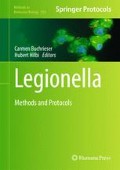Abstract
Upon uptake into a host cell, the intracellular bacterium Legionella pneumophila is not degraded on the lysosomal pathway but efficiently establishes a highly specialized replicative vacuole in which it readily multiplies. As many Icm/Dot type 4 secretion translocated bacterial effectors contribute to the establishment of this subcellular compartment in close interaction with host cell trafficking pathways, the analysis of the intracellular localization of this bacterium during infection is of pivotal importance to dissect the cellular and bacterial components of this process. In this chapter we describe a protocol for immunofluorescence microscopy in fixed mammalian and amoebal cells as well as transfection protocols to produce host cells expressing fluorescently labeled proteins as intracellular trafficking markers.
Access this chapter
Tax calculation will be finalised at checkout
Purchases are for personal use only
References
Fields BS (1996) The molecular ecology of legionellae. Trends Microbiol 4:286–290
Nash TW, Libby DM, Horwitz MA (1984) Interaction between the legionnaires’ disease bacterium (Legionella pneumophila) and human alveolar macrophages. Influence of antibody, lymphokines, and hydrocortisone. J Clin Invest 74:771–782
McDade JE, Shepard CC, Fraser DW, Tsai TR, Redus MA, Dowdle WR (1977) Legionnaires’ disease: isolation of a bacterium and demonstration of its role in other respiratory disease. N Engl J Med 297:1197–1203
Newton HJ, Ang DK, van Driel IR, Hartland EL (2010) Molecular pathogenesis of infections caused by Legionella pneumophila. Clin Microbiol Rev 23:274–298
Solomon JM, Rupper A, Cardelli JA, Isberg RR (2000) Intracellular growth of Legionella pneumophila in Dictyostelium discoideum, a system for genetic analysis of host-pathogen interactions. Infect Immun 68:2939–2947
Hägele S, Kohler R, Merkert H, Schleicher M, Hacker J, Steinert M (2000) Dictyostelium discoideum: a new host model system for intracellular pathogens of the genus Legionella. Cell Microbiol 2:165–171
Lu H, Clarke M (2005) Dynamic properties of Legionella-containing phagosomes in Dictyostelium amoebae. Cell Microbiol 7:995–1007
Joller N, Weber SS, Müller AJ, Spörri R, Selchow P, Sander P, Hilbi H, Oxenius A (2010) Antibodies protect against intracellular bacteria by Fc receptor-mediated lysosomal targeting. Proc Natl Acad Sci USA 107:20441–20446
Cocucci SM, Sussman M (1970) RNA in cytoplasmic and nuclear fractions of cellular slime mold amebas. J Cell Biol 45:399–407
Malchow D, Nagele B, Schwarz H, Gerisch G (1972) Membrane-bound cyclic AMP phosphodiesterase in chemotactically responding cells of Dictyostelium discoideum. Eur J Biochem 28:136–142
Feeley JC, Gibson RJ, Gorman GW, Langford NC, Rasheed JK, Mackel DC, Baine WB (1979) Charcoal-yeast extract agar: primary isolation medium for Legionella pneumophila. J Clin Microbiol 10:437–441
Horwitz MA, Silverstein SC (1983) Intracellular multiplication of Legionnaires’ disease bacteria (Legionella pneumophila) in human monocytes is reversibly inhibited by erythromycin and rifampin. J Clin Invest 71:15–26
Howard PK, Ahern KG, Firtel RA (1988) Establishment of a transient expression system for Dictyostelium discoideum. Nucleic Acids Res 16:2613–2623
Faix J, Kreppel L, Shaulsky G, Schleicher M, Kimmel AR (2004) A rapid and efficient method to generate multiple gene disruptions in Dictyostelium discoideum using a single selectable marker and the Cre-loxP system. Nucleic Acids Res 32:e143
Manstein DJ, Schuster HP, Morandini P, Hunt DM (1995) Cloning vectors for the production of proteins in Dictyostelium discoideum. Gene 162:129–134
Mampel J, Spirig T, Weber SS, Haagensen JA, Molin S, Hilbi H (2006) Planktonic replication is essential for biofilm formation by Legionella pneumophila in a complex medium under static and dynamic flow conditions. Appl Environ Microbiol 72:2885–2895
Tiaden A, Spirig T, Weber SS, Bruggemann H, Bosshard R, Buchrieser C, Hilbi H (2007) The Legionella pneumophila response regulator LqsR promotes host cell interactions as an element of the virulence regulatory network controlled by RpoS and LetA. Cell Microbiol 9:2903–2920
Weber SS, Ragaz C, Hilbi H (2009) The inositol polyphosphate 5-phosphatase OCRL1 restricts intracellular growth of Legionella, localizes to the replicative vacuole and binds to the bacterial effector LpnE. Cell Microbiol 11:442–460
Choi KH, Basma H, Singh J, Cheng PW (2005) Activation of CMV promoter-controlled glycosyltransferase and β-galactosidase glycogenes by butyrate, tricostatin A, and 5-aza-2′-deoxycytidine. Glycoconj J 22:63–69
Müller-Taubenberger A, Lupas AN, Li H, Ecke M, Simmeth E, Gerisch G (2001) Calreticulin and calnexin in the endoplasmic reticulum are important for phagocytosis. EMBO J 20:6772–6782
Urwyler S, Nyfeler Y, Ragaz C, Lee H, Mueller LN, Aebersold R, Hilbi H (2009) Proteome analysis of Legionella vacuoles purified by magnetic immunoseparation reveals secretory and endosomal GTPases. Traffic 10:76–87
Weber SS, Ragaz C, Reus K, Nyfeler Y, Hilbi H (2006) Legionella pneumophila exploits PI(4)P to anchor secreted effector proteins to the replicative vacuole. PLoS Pathog 2:e46
Acknowledgments
We thank Nicole Joller, Jan Faix, and Hubert Hilbi for the help in establishing these protocols. This work was supported by the Roche Research Fund for Biology, the Bonizzi-Theler Stiftung, the GEBERT-RÜF-STIFTUNG, the Swiss National Science Foundation, the Vontobel Foundation, and the Promedica Foundation, Chur, Switzerland.
Author information
Authors and Affiliations
Editor information
Editors and Affiliations
Rights and permissions
Copyright information
© 2013 Springer Science+Business Media New York
About this protocol
Cite this protocol
Weber, S.S., Oxenius, A. (2013). Immunofluorescence Imaging of Legionella Infection In Vitro. In: Buchrieser, C., Hilbi, H. (eds) Legionella. Methods in Molecular Biology, vol 954. Humana Press, Totowa, NJ. https://doi.org/10.1007/978-1-62703-161-5_16
Download citation
DOI: https://doi.org/10.1007/978-1-62703-161-5_16
Published:
Publisher Name: Humana Press, Totowa, NJ
Print ISBN: 978-1-62703-160-8
Online ISBN: 978-1-62703-161-5
eBook Packages: Springer Protocols

